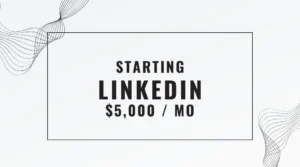Creating a solid income stream from social media without constantly spamming potential clients may seem elusive, but it’s entirely possible. Here’s a practical three-step framework for landing high-paying clients that doesn’t rely on cold messaging or having a huge following. This method has proven effective for entrepreneurs, from those just starting to seasoned professionals with tens of thousands of followers. Let’s dive into a smarter way to attract clients who value your offerings—and who seek you out.
The Problem with Mass Messaging
When it comes to landing clients, typical advice often suggests sending mass messages to hundreds of potential leads. While this may yield a few responses, it rarely converts to high-paying clients and can quickly lead to burnout. Why? Because sending a hundred DMs to get just one response is exhausting and far from scalable. Worse still, if you lose a client, you have to go back to sending hundreds of messages, competing with many others also vying for attention in the same inbox.
The reality is, mass messaging creates a perpetual cycle of outreach with little guarantee of results. It’s a hamster wheel where, for every client you secure, you’re bound to send out dozens—if not hundreds—of messages. But here’s the good news: there’s a more efficient way to attract high-quality clients that doesn’t involve DM spamming.
The Island Analogy: Casting the Right Line
Imagine you’re stranded on an island with a net and a fishing rod, starving and eager to catch fish. While it’s possible to run around the ocean with the net and catch fish by chance, it’s far more efficient to use the fishing rod, patiently casting for specific fish. In this analogy, spamming DMs is akin to wildly throwing a net, while the fishing rod represents a targeted, more strategic approach. When you use the right “bait,” your clients come to you.
Step 1: Magnetic Content as Bait
To attract clients, you need to create “magnetic content”—content that draws in the right audience and positions you as a solution to their needs. Unlike generic posts, magnetic content is designed to captivate and engage those who are likely to value your services, ultimately building a compounding asset that attracts clients over time.
- Understand Your Target Audience
Think of the challenges, needs, and goals of your audience. What problems do they need solved? What ambitions drive them? Successful magnetic content aligns with these factors, capturing attention because it resonates with specific pain points or desires. - Solve Pain Points or Fulfill Desires
At its core, magnetic content addresses your audience’s most pressing problems or desires. People are constantly seeking to ease their stress, attain financial security, or pursue status and freedom. When your content speaks directly to these motivators, it becomes an irresistible draw. - Conduct Market Research
Understanding what will appeal to your audience is essential. This can be achieved through direct audience engagement, browsing forums, or leveraging tools like ChatGPT to analyze common challenges. For instance, you could prompt ChatGPT to list the top pain points of your target audience and then flip these pain points into how-to content ideas. This provides a wealth of content that speaks directly to the issues that matter most to your potential clients.
Step 2: Casting Your Line – Creating Engaging Content
Now that you’ve identified the right “bait,” it’s time to cast your line into the waters of social media. This doesn’t just mean creating content but creating it in a way that genuinely engages and draws potential clients to you. Many people struggle at this stage, often because they lack a clear, repeatable framework to create impactful content. Without structure, you may find yourself staring at a blank screen, uncertain about where to start or how to structure your ideas. This lack of direction can make content creation feel daunting, causing burnout or disengagement over time. Worse, content that lacks clarity and purpose often leads to little or no engagement, making it challenging to attract clients.
However, with the right approach, you can make content creation both simpler and more effective. By following a step-by-step framework, you can streamline your process and make content that resonates with your audience, which leads to higher engagement and a greater chance of converting followers into clients. This approach not only saves time but also helps establish you as a knowledgeable and reliable source in your niche.
The Content Creation Framework
Here’s a framework for structuring content that engages your audience and positions you as a solution to their problems:
- Pick a Pain Point: Begin with a common issue from the list you created in Step 1. This pain point will act as the central theme of your content.
- Outline the Steps to Solve the Problem: List out the steps someone would need to take to overcome this challenge. Think of your content as a bridge between your audience’s pain point and their desired outcome.
- Answer Three Key Questions:
- What is the step?
- Why should the audience care?
- How can the audience take action?
Answering these questions ensures your content is not only informative but actionable, allowing your audience to see immediate value. This approach adds depth and clarity to your content, helping your followers understand the importance of each step and empowering them to act. As they find real solutions to their challenges in your posts, they’ll begin to view you as a valuable and reliable resource.
For example, if your topic is about gaining high-paying clients on social media, break it down into actionable steps and answer why each step is important. In doing so, you’re showing your audience that you have a clear and effective plan—something that will keep them coming back to you as a trusted source.
Crafting Magnetic Content with Real-World Examples
One way to enhance the impact of your content is by sharing real-world examples. Case studies, whether personal or based on a client’s journey, add authenticity and credibility. They illustrate that you’re not only discussing theories but have practical experience in solving these problems. Showcasing tangible results gives your audience proof that your methods work and increases their trust in your expertise.
Additionally, this framework can be adapted across different content types. Whether you’re creating YouTube videos, writing posts for your blog, or drafting a newsletter, structuring content with these principles will make it more engaging and persuasive.
Why Structure Matters in Content Creation
A well-structured piece of content is like a roadmap for your audience. It provides clarity, makes it easy for them to follow along, and ultimately guides them towards a solution. Many creators overlook the importance of this step, which often leads to content that feels scattered or hard to digest. By sticking to a consistent framework, you’ll find that your content creation process becomes faster and more efficient. More importantly, your audience will find your content easier to understand and act upon, which is essential for building a loyal following and converting followers into paying clients.
Example of Structured Content for Engagement
Suppose you’re creating a post about attracting high-paying clients without sending DMs. Start by highlighting the pain point (wasting time with mass messaging), and then outline the solution (creating magnetic content). Explain each step of the process, from researching audience pain points to developing engaging posts. Show your audience how they can do this themselves by walking them through your framework, and they’ll begin to see you as someone with the answers they need. This trust is crucial when you eventually offer a service or product to solve more of their problems.
In this way, structured content allows you to convey your message clearly and effectively, positioning you as a problem-solver that high-paying clients can turn to. And remember, consistency is key. The more you create structured content that helps your audience, the more they will come to you, rather than the other way around.
Step 3: Reeling Them In – Turning Engagement into Clients
Now that your audience is engaging with your well-crafted content, it’s time to take the final step: converting those followers into paying clients. This can be a delicate process, as you don’t want to come across as overly sales-focused. Instead, think of it as a natural next step in your relationship with followers who already trust you and see you as an authority.
Many creators struggle here because they’re either too hesitant to make an offer or too aggressive in their approach, which can alienate potential clients. When done correctly, converting followers into clients feels like a natural extension of the relationship. The key is to provide a clear and enticing path for those who are interested in more than just your free content.
To help you master this step, let’s break down how to design an offer, guide your audience toward it, and follow up in a way that feels authentic and client-centered.
Designing Your Offer – Making It Irresistible
The first step in converting followers into clients is crafting an offer that speaks directly to their needs. Remember, these are people who have been following you because they resonate with your insights and solutions. Your offer should be designed as an extension of the value you’ve been providing, offering a deeper or more personalized level of support.
Elements of a Compelling Offer
- Clear Solution: Your offer should address a specific problem your audience faces. For example, if you’ve been providing tips on social media engagement, your offer might be a course or coaching program that provides step-by-step guidance on creating viral content.
- Concrete Benefits: Focus on outcomes rather than just features. Instead of saying “5 modules of training,” highlight what each module will enable them to achieve.
- Social Proof: Testimonials, case studies, or examples of past results can help potential clients feel confident that they’re making the right choice. Highlight specific client success stories if you have them.
- Limited Availability or Time Sensitivity: Scarcity and urgency can motivate hesitant clients to take action. Offering limited spots or early-bird pricing can be effective if used authentically.
Once your offer is well-crafted, you’ll want to guide your audience toward it without feeling pushy. This involves strategic content creation and personalized follow-ups for those who express interest.
Nurturing Leads Through Strategic Content
You’ve already laid the groundwork with valuable, actionable content. Now, you can use a mix of educational posts, testimonials, and subtle calls to action (CTAs) to create a bridge from engagement to conversion. Here are some strategies to help:
- Educational Posts with CTAs: Continue sharing insights and tips, but start adding CTAs that invite followers to learn more or schedule a call. For example, a post about overcoming common business obstacles can end with a soft CTA like, “Want a personalized strategy to take you further? Message me to discuss how I can help.”
- Live Q&A Sessions: Hosting live sessions can be a powerful way to connect directly with your audience and answer any questions they may have. This allows you to share your expertise in real time, address concerns, and mention your offer as a solution to recurring issues.
- Success Stories: Share testimonials or case studies as part of your content strategy. Posts highlighting real-world results help potential clients envision their own success and build trust in your methods.
These content pieces guide your audience toward a decision without forcing a sale. By consistently adding value and mentioning your offer as a logical next step, you give your followers the opportunity to take action when they’re ready.
Converting Leads into Clients – The Follow-Up Process
For those who show interest, a personal follow-up can be the difference between a lukewarm lead and a committed client. The key here is to focus on helping rather than selling. Approach every conversation with the mindset of genuinely understanding their needs and whether your offer is the right fit.
- Qualifying Questions: Start by asking questions that let you understand their goals, challenges, and level of commitment. This is where you’ll gain insight into how you can help them and whether they’re ready for your offer.
- Personalized Recommendations: Based on their responses, share how your services can specifically address their needs. This is also a chance to highlight unique aspects of your offer that align with their goals.
- Overcoming Objections: If potential clients have concerns or hesitations, acknowledge them respectfully. Rather than trying to “convince” them, provide clarity. For instance, if they’re unsure about the investment, discuss the long-term value and possible ROI.
- Setting Clear Next Steps: Whether it’s booking a call or signing up directly, make the next step clear and easy to follow. Ensure they know what they’ll gain from taking action now.
Following up in a way that feels supportive rather than sales-focused builds trust and often leads to a higher conversion rate. You want them to feel that working with you is a natural progression of the journey they’ve already started by engaging with your content.
Maintaining Momentum – Turning Clients into Loyal Advocates
Once you’ve successfully converted followers into clients, your job isn’t over. The experience they have as clients is critical for generating referrals, testimonials, and repeat business. Client satisfaction and loyalty can have a powerful impact on your long-term success.
- Deliver Beyond Expectations: Once they’ve signed on, focus on providing as much value as possible. Consistently deliver results, check in regularly, and address any challenges proactively.
- Ask for Feedback: Use each client engagement as a learning experience. Asking for feedback can help you refine your offer, address potential gaps, and demonstrate your commitment to continuous improvement.
- Encourage Referrals: Happy clients are often eager to share their experiences with others. Offering referral incentives or discounts for clients who bring in new business can create a steady stream of qualified leads.
- Collect Testimonials: Positive reviews and testimonials are invaluable for attracting new clients. Make it easy for clients to provide feedback, and use their testimonials in your content to enhance social proof.
Wrapping It All Up: A Repeatable Process for Long-Term Success
Congratulations! You now have a comprehensive, repeatable process for attracting, engaging, and converting high-paying clients on social media. By starting with a deep understanding of your audience’s pain points, creating value-driven content, and building an authentic relationship with your followers, you’re setting yourself up for sustainable success. This strategy not only helps you attract ideal clients but also positions you as a trusted expert in your niche.
To recap, here’s the full process:
- Bait the Hook: Research and identify your audience’s core pain points.
- Cast the Line: Create structured, engaging content that addresses these pain points.
- Reel Them In: Guide interested followers towards your offer, nurture leads, and provide a clear path to becoming a client.
With this approach, you’ll find that the journey from follower to client becomes natural, as each step in your content strategy aligns with their needs and builds trust. By following this framework, you can grow a loyal client base and establish a thriving business through social media—no cold DMs required!




